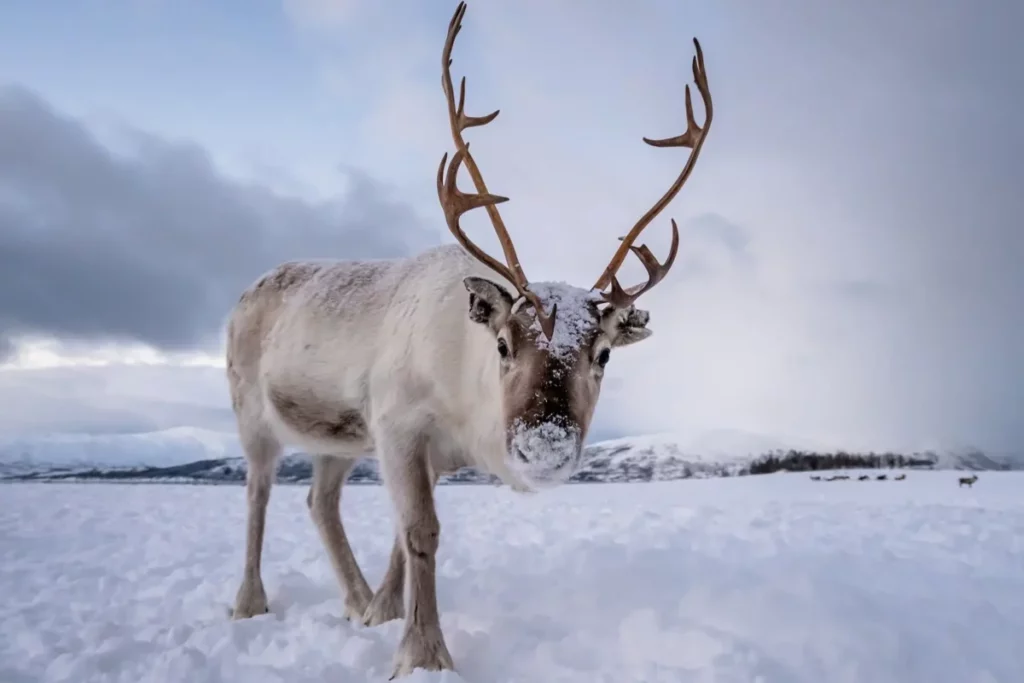Tales of St. Nicholas have etched a love for these famous cold-weather deer, but do you know which is which when it comes to Caribou vs Elk?
If someone says the word “deer,” I’ll bet I know what comes to your mind: Bambi. Certainly, that’s what goes through my mind. Many children grew up reading the 1923 novel Bambi, a Life in the Woods by Austrian author Felix Salten. It’s such an important book in children’s literature that it has been reissued this year, its one hundredth, in two new translations from the German by two different publishers. For those who haven’t read the book, there’s the 1942 classic Disney animated film.
Bambi and his cohort defined the word “deer” for me. But I had to broaden my ideas. There’s a whole world of deer out there that aren’t European roe deer as Bambi was in the book or American white-tailed deer as in the movie.
I grew especially interested in caribou, also called reindeer in many parts of the world, when I started writing a series of novels that featured an Inuit character, Jack O’Malley, and his American wife, Anne. Caribou were and are integral to the Inuit culture.
The first novel of my “Anne O’Malley series,” Quest for the Ivory Caribou, takes place in northern Quebec on the Ungava Peninsula, which is the home of the Leaf River Herd. This herd is one of three subgroups of the Quebec-Labrador herd, thought to be a half million strong, the largest group of migratory caribou in the world. They belong to the sub-species of boreal or forest caribou that migrate between the forest and the tundra.
My second novel, Twenty-Six Eskimo Words, takes place in Alaska and features the Porcupine Herd. This herd and the Canadian Bathurst Herd share the record for the longest terrestrial annual migrations on earth. Many bird species migrate from pole to pole. Monarch butterflies and blue, gray, and humpback whales outdo caribou too, but the two herds each migrate about 839 miles a year round-trip measured on a straight line. Of course, they don’t actually walk in a straight line when navigating through mountains, and that 839 miles doesn’t include the mileage they put in walking around looking for food on the migration and at either end. Counting that, they walk between 2,000 and 3,000 miles per year. One of their names is “Wanderer.”
My teachers so often said that to really learn about something it helps to compare and contrast it with something else. As I really became involved in reading and researching about caribou, I came to think it would be interesting to compare them to another animal in the same family, the elk.
Since this article is a comparison of caribou vs elk, I looked for books similar to Bambi but featuring caribou or elk. I was sure I wouldn’t find one about caribou vs elk since they don’t normally share the same range. I found a number of children’s nature and science books about them, but I didn’t find a single novel featuring either a caribou or elk character. I found that surprising. No matter how much has been written about a subject, usually there is at least one more author somewhere willing to give it a try.
Caribou vs Elk – World Distribution
If you look at deer in general, they fill an amazing number of ecological niches in the world. They’re native or introduced and thriving in all parts of the world except the poles and sub-Saharan Africa. A good example of that can be seen in the analysis of caribou vs elk.
Caribou (Rangifer tarandus), tuktu in the Canadian Inuit language, Inuktituk, and tuttu in the Inupiat language of the Alaskan Inupiat people. The same Rangifer tarandus is called reindeer in much of the rest of the world, though each culture has its own word for them. Caribou are a type of deer (Family Cervidae) that now live in arctic and subarctic areas in North America and Greenland. Their numbers and territory have shrunk radically. Paleontologists have evidence that eleven thousand, seven hundred years ago they were hunted by Paleo-Indians as far south as what is now New Mexico.
Their habitat has continued to shrink in the last few hundred years. As recently as the 19th century, caribou lived in southern Canada, Washington, Idaho, Montana, and New England.
On January 14, 2019, the last wild caribou in the contiguous 48 states was taken into captivity. A cow, she belonged to the South Selkirk caribou herd that had lived in and migrated through the mountains of Washington, Idaho, and lower British Columbia. The herd dwindled as the home range was logged. Logging opened the area to competitors, especially moose and deer, and predators, including mountain lions, bears, and wolves. The habitat the caribou were adapted to disappeared.
That last U.S. caribou was to be integrated into a herd farther north in British Columbia, but that herd is also slowly dwindling as its habitat disappears due to logging. Her ultimate fate and that of her new herd is in doubt.
Scientists estimate that there are three-and-a half million wild caribou in North America (plus a million wild reindeer and three million domestic reindeer in Eurasia).
In fact, almost all the wild caribou herds in North America are dying off, as are many in Eurasia. When you look at the absolute numbers, it seems as though caribou are doing okay, but they’re all under pressure, and herds are diminishing, not growing.
For a mildly technical discussion of this, you may want to check Declining caribou population victim of ecological chain reaction (phys.org). A second interesting article on the problems involved in counting herds in the wild is Counting Caribou, Alaska Department of Fish and Game.
Both caribou and elk are true deer. True deer are in the taxonomic family Cervidae. (Taxonomy is a specialized science that names, describes, and classifies living things.) Not everything needs to be confusing. Cervus is Latin for “deer.” It’s as simple as that.
As true deer, caribou and elk have many things in common, some obvious, some more subtle. The two most obvious characteristics they have in common are their antlers and hooves.
Caribou vs Elk – Hooves
 Caribou and elk are both even-toes ungulates. The word “ungulate” generally refers to animals with hooves, though whales, dolphins, and porpoises fit in this category. Even-toed means that these animals actually use two or four of the five toes that were part of the ancestral ungulate foot structure. Caribou and elk each use two. The first toe seems to have disappeared and toes two and five have evolved into dewclaws used for balance and anchoring on slippery or marshy ground. Caribou and elk walk on toes three and four, using the overdeveloped toenails called hooves. This puts caribou and elk in the same group with hippopotamuses, pigs, giraffes, and cattle, along with many other creatures. (Odd-toed ungulates include some familiar faces too: horses, rhinoceroses, tapirs and zebras. They walk on toe number three.)
Caribou and elk are both even-toes ungulates. The word “ungulate” generally refers to animals with hooves, though whales, dolphins, and porpoises fit in this category. Even-toed means that these animals actually use two or four of the five toes that were part of the ancestral ungulate foot structure. Caribou and elk each use two. The first toe seems to have disappeared and toes two and five have evolved into dewclaws used for balance and anchoring on slippery or marshy ground. Caribou and elk walk on toes three and four, using the overdeveloped toenails called hooves. This puts caribou and elk in the same group with hippopotamuses, pigs, giraffes, and cattle, along with many other creatures. (Odd-toed ungulates include some familiar faces too: horses, rhinoceroses, tapirs and zebras. They walk on toe number three.)
Caribou hooves, the largest in all deer species, are especially interesting. The animals have four toes on each foot. Two of those toes are dewclaws. They are useful for traction when the animal is walking through deep snow. The other two toes form a split (cloven) concave hoof that spreads as the animal walks. The hooves function equally well as “snow-shoes” when walking across winter snow or spongy tundra or muskeg, as shovels when the caribou are digging for their primary winter food of lichens and small shrubs, and as paddles when the animals swim streams, rivers, and lakes during their annual migrations. Those paddle-like hooves make them very good swimmers.
It’s amazingly difficult to find similar information about elk hooves. If you try on the internet, you will find seemingly endless information on elk hoof disease, evidently a hot topic these days, and on how to kill elk, but practically nothing on foot anatomy or evolution. Suffice it to say that although elk are substantially bigger that caribou, their cloven hooves are smaller, narrower, and leave a track showing two crescent shapes. The smaller size may be because though they thrive in and prefer snowy country, they don’t live in snow as deep or long-lasting as the caribou do. Caribou live in territories where snow is on the ground nine months or more per year. Also, like caribou, elk migrate, but for much shorter distances.
Caribou vs Elk — Antlers
 Both bull and cow caribou grow antlers every year. The cows are the only female deer that do so. Females’ antlers are small and can weigh between three and seven pounds. Large bulls can have antlers measuring as long as 51 inches, which can weigh up to 33 pounds. The bulls drop their antlers in November, after the rut, the cows in early spring, shortly after giving birth. One proposed explanation for this difference in timing is that it makes it easier for cows to compete for winter forage with the much larger bulls.
Both bull and cow caribou grow antlers every year. The cows are the only female deer that do so. Females’ antlers are small and can weigh between three and seven pounds. Large bulls can have antlers measuring as long as 51 inches, which can weigh up to 33 pounds. The bulls drop their antlers in November, after the rut, the cows in early spring, shortly after giving birth. One proposed explanation for this difference in timing is that it makes it easier for cows to compete for winter forage with the much larger bulls.
In the caribou vs elk comparison, caribou grow to average between 350 and 400 lbs. Elk average between 650 and 850 lbs. Still, the smaller caribou win the antler competition as they did with hooves. Elk bulls’ antlers can grow as much as an inch a day, and can grow to weigh 22-24 lbs. apiece, so they’re not as large as caribou antlers.
Antlers function both as threats and weapons in male-male competition during mating season. They also are attractive to females and may signal that the male is a suitable mate choice. Growing antlers is “expensive” requiring a lot of calories over a long period to grow. They indicate the bull’s nutritional status and general health.
Because they are calorically expensive to grow, you might think it would make sense for deer to grow their antlers only once in their lifetimes, but antlers can be damaged during the male-male antler-wrestling that is common during breeding season. Once damaged, they do not regenerate. A bull with damaged antlers would be at a disadvantage during all subsequent breeding seasons if he couldn’t shed old antlers and grow new ones.
Caribou vs Elk — How are they Caribou and Elk different?
The most important difference, of course, is that caribou live in the far north, the land of the midnight sun, where there may be snow on the ground nine months of the year, where severe storms often rage, and where there may be no daylight for two months in the winter.
Although Elk prefer living in snow country and thrive there, the cold weather is not as severe or as long-lasting as in the sub-arctic areas that are home to caribou. Caribou are smaller bodied because calories are more difficult to acquire, but larger hooves and antlers give greater survivability in their ecosystem.
Caribou vs Elk — invasive species
Wherever you have lived in the world, except for the North Pole, the South Pole, and sub-Saharan Africa, you’ve lived near deer. Where they didn’t occur naturally, humans have introduced them. The IUCN (International Union for the Conservation of Nature) have called for urgent action to reduce the impact of invasive species on native ecosystems. That probably translates to elimination of the invasive creatures.
Caribou vs Elk – an Invasive Elk Story
For example, there are no deer native in Australia or New Zealand, but introduced deer have adapted and thrive. Six species of deer currently do well in Australia, including the chital, hog, rusa, and sambar—all Asian deer—and European red deer and fallow deer. New Zealand has rusa, sambar, red deer, and fallow deer, plus, sika deer (from East Asia), and whitetail deer and elk (cervus elaphus nelsoni also known as Rocky Mountain Elk) from the US. They were introduced in the 1800s and 1900s to provide sport-hunting opportunities for British settlers.
Unfortunately, the deer were introduced into areas where they had no predators other than humans. They rapidly reproduced to the point that they were eating their way through ecosystems and leaving destruction behind. The IUCN has declared elk and red deer to be invasive species in New Zealand.
Caribou vs Elk – an Invasive Caribou Story
Going back to our consideration of caribou vs elk, caribou, generally known as reindeer outside of the US and Canada, are native to the circumpolar areas of Norway, Finland, Russia, Mongolia, Northern China, Alaska, Canada, and Greenland. They used to be common in the northern parts of the continental US from Washington to Maine, but are now extinct there.
As with the elk in New Zealand, caribou were introduced to a large island, Iceland. King Christian VII of Norway thought that Norwegian Icelanders could make a living as reindeer herders, so between 1771 and 1787, four groups of reindeer were turned loose in four different areas. The first three groups died out rapidly. The fourth managed to maintain a “hoof-hold.” As with New Zealand, they had no natural predators, but winters were so harsh and browse was so poor in quantity that survival was difficult. Thus, reindeer herding turned out not to be a viable concept for Iceland. Currently there are about 7,000 wild reindeer under management there. Hunting permits are issued each year to their only predators, humans, to keep the herd a viable size. Without hunting, a number would starve. As a side note, all land-living mammals in Iceland (including humans), except the arctic fox, were introduced by humans at various times.
Caribou vs Elk – General Taxonomy
Taxonomy is a specialized science that names, describes, and classifies living things. The underlying idea is that all living things are related in some way. Taxonomy studies single-celled and multi-celled organisms and categorizes them according to what they have in common.
Taxonomy began with the ancient Greeks. They looked at life in a systematic way and noted the most obvious categories: plants and animals.
Modern taxonomies are more complex, even for the people whose life’s work they are, and they change as our understanding of life and evolution becomes more sophisticated.
In one system, generally in use in the United States and Canada, scientists divide life into three domains: Archaea, Bacteria, and Eukarya. Archaea and Bacteria are single-celled creatures. Eukarya are multi-celled plants and animals and include, among many others, caribou, elk, and us.
Caribou vs Elk — Kingdoms
Domains are further divided into kingdoms, one of which is the ancient Greek category of animalia or animals. The kingdoms include Animalia, Plantae, Fungi, Protista, Archaea/Archaebacteria, and Bacteria/Eubacteria.
Here’s how caribou vs elk stack up, or down, depending on your perspective.
Caribou vs Elk
Kingdom: Animalia Animalia
Phylum: Chordata Chordata
Class: Mammalia Mammalia
Order: Artiodactyla Artiodactyla
Family: Cervidae Cervidae
Subfamily: Capreolinae Cervinae
Tribe: Odocoileini
Genus: Rangifer Cervus
Species: R. tarandus C. canadensis
Binomial name: Rangifer tarandus Cervus canadensis
Note: it’s usual for the species and binomial names to be written in italics. The genus name has an initial capital. The species name is in lower case, as above.
Caribou vs Elk — Phylum
Kingdoms are divided into phylums. Caribou, Elk, and again, humans are in the phylum Chordata. Chordates are defined by a hollow dorsal nerve cord, a notochord, pharyngeal slits, an endostyle, and a post-anal tail. There’s a footnote to all this. You and I are chordates. I, for one, don’t have a post-anal tail, but I did when I was a fetus, as did you. So the characteristics that classify us can occur at any stage of life. This gives you just a little taste of how complicated taxonomy is.
Well, back to caribou vs elk.
Caribou vs Elk — Class
The next level is class. Humans are still with caribou and elk in the class mammalia, or mammals, as we often say. We have mammary glands that produce milk for feeding our offspring, a neocortex in the brain, fur/hair, and three bones in the middle ear.
Caribou vs Elk — Order
The next level is order, and here’s where we separate from caribou and elk. We are primates. Caribou and elk are artiodactyla (even-toed ungulates). Ungulates have hooves which are made up of two of their five toes.
Strangely, caribou and elk are in the same order with camels, pigs, hippopotamuses, and even whales! It seems that the more complicated taxonomy gets, the more interesting it gets.
Caribou vs Elk — Family
If you want to follow up on whales, I’ll leave you to it, and good luck. We’re going to continue with caribou vs elk, and we’re going to lose the whales at the next level: the family. In this case, caribou and elk are both cervidae or true deer.
I don’t think the taxonomists mean to confuse us, but strangely, there are a number of things that look like deer, but aren’t. True deer grow and shed their antlers each year. Creatures like antelopes, that have permanent antlers/horns; musk deer; and chevrotains are in different families.
Another confusion, water deer, native to China and Korea, are true deer, but they don’t grow antlers at all. They have fangs. I’m not kidding. Life is interesting!
Caribou vs Elk — Subfamily
It’s at the subfamily level that caribou finally split from elk. Caribou are Capreolinae and Elk are Cervinae. It’s likely that they split from each other in central Asia between 7.7 million and 11.5 million years ago. The Capreolinae are called New World Deer, although some of them, including reindeer, moose, and roe deer live in Eurasia. The Cervinae are called Old World Deer.
So, what is the main difference between them, at least in the minds of taxonomists? It’s the structure of the ankle.
Caribou vs Elk — What may the future hold?
Wild deer herds all over the world are trending downward. Humans have eliminated the predators—bears, lions, wolves, coyotes, and others—that keep herds healthy by culling the elderly and ill. Human hunters cull the biggest, healthies males. Males of many species are actually decreasing in size, as are their antlers. Bigger no longer necessarily means better reproductive success. At the same time, we are systematically logging forests, mining, converting the wild to farms and housing subdivisions, and in general, damaging ecosystems. Forest and animal management has some influence, as with the last caribou in the 48 contiguous states, the trend continues. Deer are not as visible or dramatic and elephants, but our grandchildren and great-grandchildren may no longer have an opportunity to deer in the wild. The trend continues. They may not have an opportunity to do a comparison of caribou vs elk.










